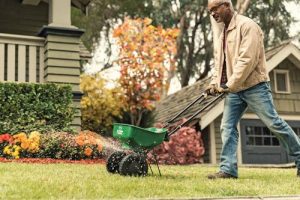Whether you’re an avid gardener or focus more on lawn care and landscaping, you’re definitely kept busy from late summer into early fall. While your to-do list may start to feel a little overwhelming with all the lawn and garden tasks that must be taken care of at this time of year, don’t let reseeding your lawn be the one that falls by the wayside.
Preparing the Ground for Seed
In Wisconsin, August 15 through September 15 is the perfect time frame for lawn care and reseeding those bare patches that are ruining the otherwise picture-perfect surface of your lawn. Any bare areas that are bigger than a dinner plate should be reseeded, but more must be done than tossing a handful of seeds on the dirt. There’s a reason why grass wasn’t growing there in the first place: the soil wasn’t able to support it. To address this problem, start by applying some compost to enrich the soil. To get the best results, take the time to break up the soil and really work in the compost, rather than simply layering it over the dirt. Once the compost is well-incorporated into the soil, you should then add a layer of starter fertilizer.
 Seeding & Mulching
Seeding & Mulching
Once the soil has been amended and prepared, seed can be sown. Rake the seeds in and mix them throughout the top quarter- to half-inch of the soil to aid in germination, then press the soil down firmly with your foot. If this step is skipped and the seed is just scattered on the ground, you’re basically wasting your time, because that method is sure to fail. While mulching after seeding is recommended, make sure that it’s a light layer. You want to see equal amounts of straw to soil, so a 50/50 mix is best.
Not All Grass Is Equal
When choosing your grass seed, Kentucky bluegrass is one of your best options, due to the fact that it’s drought-resistant and spreads by creeping, which is good if you have a fair amount of ground you want it to cover. When choosing your seed mix, don’t worry so much about the type of mix; rather, check the back for the percentages of the different types of seeds that make up the mix. Choose the one that has the highest percentages of Kentucky bluegrass and fine fescue, and a minimum of annual and perennial ryegrass. This combination will provide the best chance for the seed to survive the winter and fill out your lawn nicely come spring.
Remodel Your Exterior With the Pros
Along with lawn care, getting your gutters ready for winter is another important fall task. If cleaning out messy gutters is your least favorite fall chore, consider investing in gutter guards to keep leaves, twigs, and other debris out. If this is something you are interested in, call Callen at 414-765-2585 to find out more about our Gutter Topper® gutter protection system and its impressive Lifetime Guarantee.


